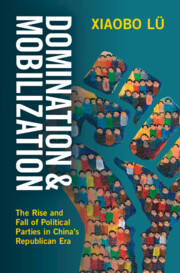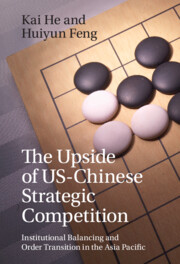13089 results in East Asian government, politics and policy
A Hundred Flowers
- How Literature Shaped Maoism
- Coming soon
-
- Expected online publication date:
- October 2025
- Print publication:
- 31 October 2025
-
- Book
- Export citation
The Mediation System of China from an Interdisciplinary Perspective
- Coming soon
-
- Expected online publication date:
- October 2025
- Print publication:
- 01 October 2026
-
- Book
- Export citation
Politicizing Business
- How Firms Are Made to Serve the Party-State in China
- Coming soon
-
- Expected online publication date:
- September 2025
- Print publication:
- 30 September 2025
-
- Book
- Export citation

Domination and Mobilization
- The Rise and Fall of Political Parties in China's Republican Era
- Coming soon
-
- Expected online publication date:
- July 2025
- Print publication:
- 31 July 2025
-
- Book
- Export citation
Governance of a Party-state
- Corruption, Law, and the Modus Operandi of the Chinese Communist Party
- Coming soon
-
- Expected online publication date:
- July 2025
- Print publication:
- 31 July 2025
-
- Book
- Export citation

From Manners to Rules
- Advocating for Legalism in South Korea and Japan
- Coming soon
-
- Expected online publication date:
- June 2025
- Print publication:
- 30 June 2025
-
- Book
- Export citation

The Upside of US-Chinese Strategic Competition
- Institutional Balancing and Order Transition in the Asia Pacific
- Coming soon
-
- Expected online publication date:
- May 2025
- Print publication:
- 31 May 2025
-
- Book
- Export citation

Beyond Coercion
- The Politics of Inequality in China
- Coming soon
-
- Expected online publication date:
- April 2025
- Print publication:
- 30 April 2025
-
- Book
- Export citation
Switching Diplomatic Recognition Between Taiwan and China: Economic and Social Impact Edited by Chien-Huei Wu. London and New York: Routledge, 2024. xii + 240 pp. £101.00 (hbk). ISBN 9781032442860
-
- Journal:
- The China Quarterly , First View
- Published online by Cambridge University Press:
- 27 March 2025, pp. 1-2
-
- Article
- Export citation
Remembering Li Keqiang: Policy Divergence in Zhongnanhai and Its Economic Consequences
-
- Journal:
- The China Quarterly , First View
- Published online by Cambridge University Press:
- 10 March 2025, pp. 1-19
-
- Article
-
- You have access
- Open access
- HTML
- Export citation
Women and their Warlords: Domesticating Militarism in Modern China Kate Merkel-Hess. Chicago, IL: University of Chicago Press, 2024. 245 pp. $45.00 (hbk). ISBN 9780226834306
-
- Journal:
- The China Quarterly , First View
- Published online by Cambridge University Press:
- 10 March 2025, pp. 1-2
-
- Article
- Export citation

Japan's New Industrial Policy
-
- Published online:
- 07 March 2025
- Print publication:
- 03 April 2025
-
- Element
- Export citation
Appendix A
-
- Book:
- Dominance Through Division
- Published online:
- 01 March 2025
- Print publication:
- 06 March 2025, pp 321-344
-
- Chapter
- Export citation
5 - Perfect Storm Conditions for Tournaments in Japan
-
- Book:
- Dominance Through Division
- Published online:
- 01 March 2025
- Print publication:
- 06 March 2025, pp 137-172
-
- Chapter
- Export citation
Tables
-
- Book:
- Dominance Through Division
- Published online:
- 01 March 2025
- Print publication:
- 06 March 2025, pp xvii-xx
-
- Chapter
- Export citation
Copyright page
-
- Book:
- Dominance Through Division
- Published online:
- 01 March 2025
- Print publication:
- 06 March 2025, pp viii-viii
-
- Chapter
- Export citation
Index
-
- Book:
- Dominance Through Division
- Published online:
- 01 March 2025
- Print publication:
- 06 March 2025, pp 363-366
-
- Chapter
- Export citation
7 - Which Electoral Districts Get More Money
-
- Book:
- Dominance Through Division
- Published online:
- 01 March 2025
- Print publication:
- 06 March 2025, pp 233-271
-
- Chapter
- Export citation
Little to Lose: Exit Options and Attitudes towards Automation in Chinese Manufacturing
-
- Journal:
- The China Quarterly , First View
- Published online by Cambridge University Press:
- 06 March 2025, pp. 1-21
-
- Article
-
- You have access
- Open access
- HTML
- Export citation
4 - Second Prize Is a Set of Steak Knives
-
- Book:
- Dominance Through Division
- Published online:
- 01 March 2025
- Print publication:
- 06 March 2025, pp 108-136
-
- Chapter
- Export citation

